RGNT REBORN
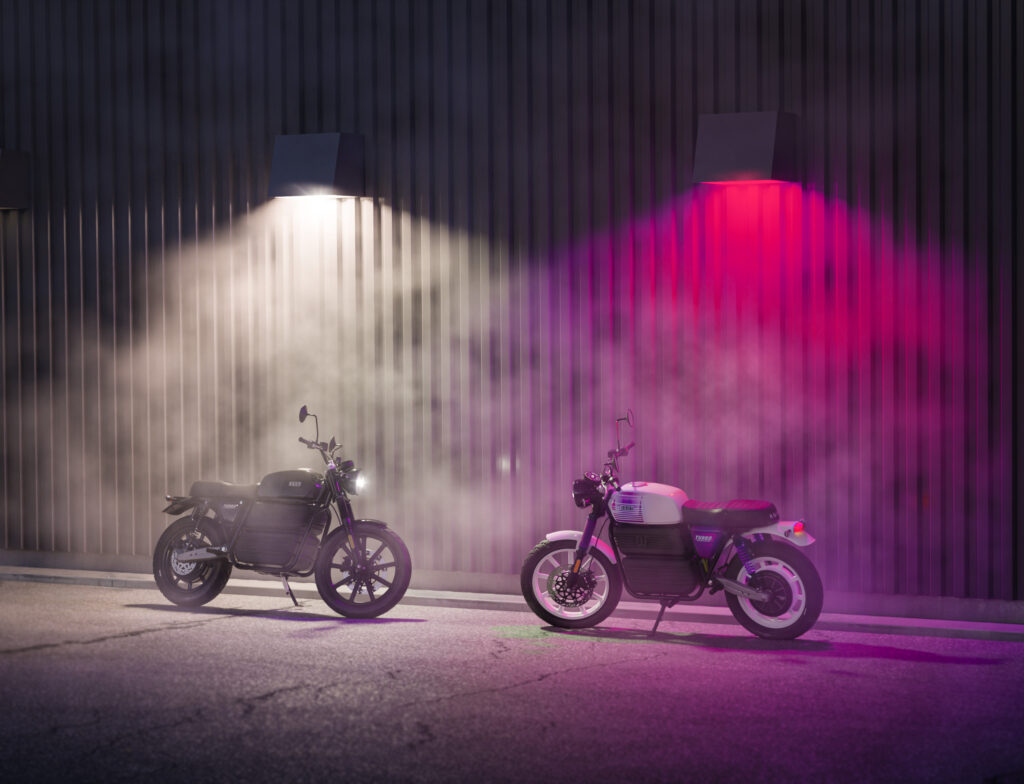
The idea for RGNT was born during a business trip Jonathan took to Beijing in 2018, following a new regulation that required all two-wheeled vehicles to run on electricity. At the time, Jonathan’s other company, Annevo – founded in 2014 – had grown to around 50 employees. After building up several other businesses, Jonathan now saw the potential to create a motorcycle that was more stylish, more practical, and most importantly, tailored to European standards and taste.
RGNT Motorcycles was founded around New Year 2019, and Jonathan sold his remaining shares in Annevo that same year to go all in on electric motorcycles. The first time I met Jonathan was in autumn 2019, at RGNT’s then showroom in Stockholm. Already at that time, RGNT’s first prototype was complete: the RGNT No.01. When we met again in 2021 in Kungsbacka, the second generation was in the works. But at that point, according to Jonathan, it felt like a Sisyphean task – a constant struggle with little progress.
Like many growth companies, RGNT required external funding – which led to a clash with the new owners. Differing visions caused friction, and Jonathan left the company in the spring of 2022. In December 2023, RGNT Motorcycles filed for bankruptcy.
When I ask Jonathan what he thinks went wrong, he replies:
“There were several factors. Partly a culture clash with foreign investors, which created a toxic working environment. Then we tried to fill a market gap that didn’t really exist, all while ten other electric motorcycle manufacturers were attempting the same thing. You can’t force development – it needs time to be tested and refined. For someone without prior experience in vehicle manufacturing, it’s hard to know what actually works.”
If I haven’t made it clear by now that Jonathan is a true entrepreneur, let me say it outright – the story doesn’t end here.
The Rebirth
In February 2024, Jonathan acquired all remaining assets from the bankruptcy estate through a new company: RGNT Reborn AB. With the support of their European dealers, they managed to sell out the entire stock of second-generation bikes, securing fresh capital to restart operations.
“It turned out to be an expensive deal in hindsight, but worth every penny for my personal growth. And it’s incredibly exciting to get to do this again. Most of our competitors have more or less gone bankrupt by now, but RGNT has risen again – and today we’re a profitable company,” says Jonathan.
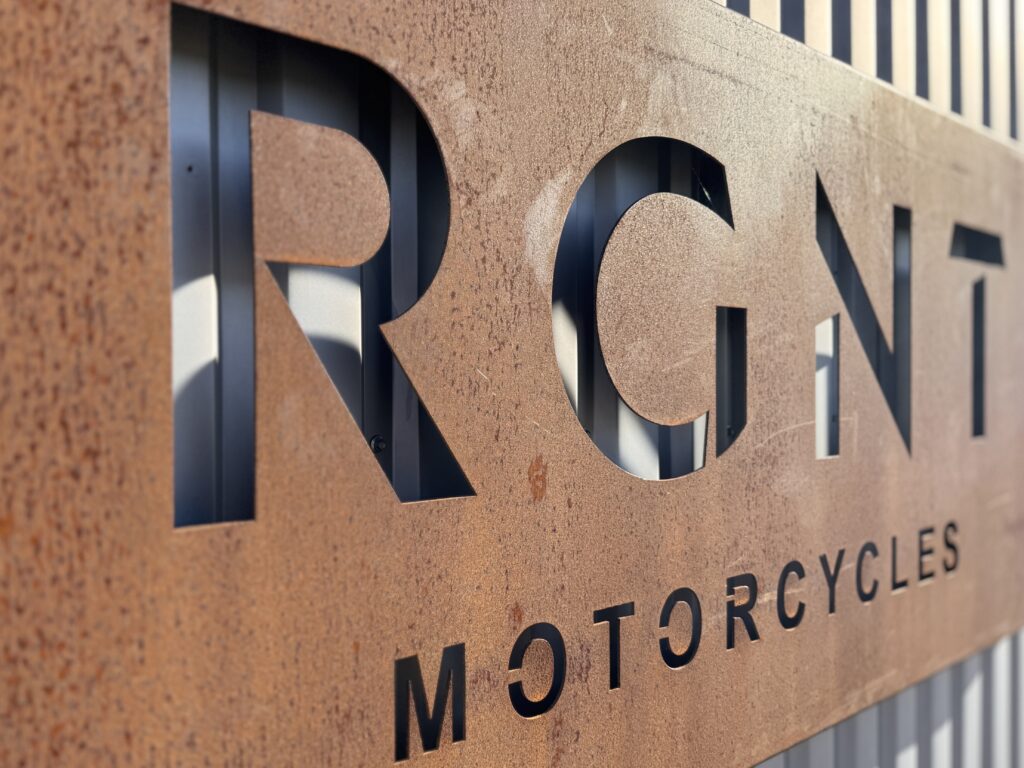
After operating out of Kungsbacka and Ringön in Gothenburg, RGNT is now based in Åskloster, just north of Varberg. On a workbench sits the first unit of the third-generation model: the RGNT Turbo in ‘Black Thunder’ livery, frame number 001. It’s so fresh that Jonathan realises, mid-conversation, that it’s the first time he’s actually seen it fully assembled. He looks genuinely proud, noting that RGNT always keeps the first example for themselves. So far, there are 50 pre-ordered motorcycles to be assembled in the coming weeks and delivered. This year’s total planned production stands at 250 units.
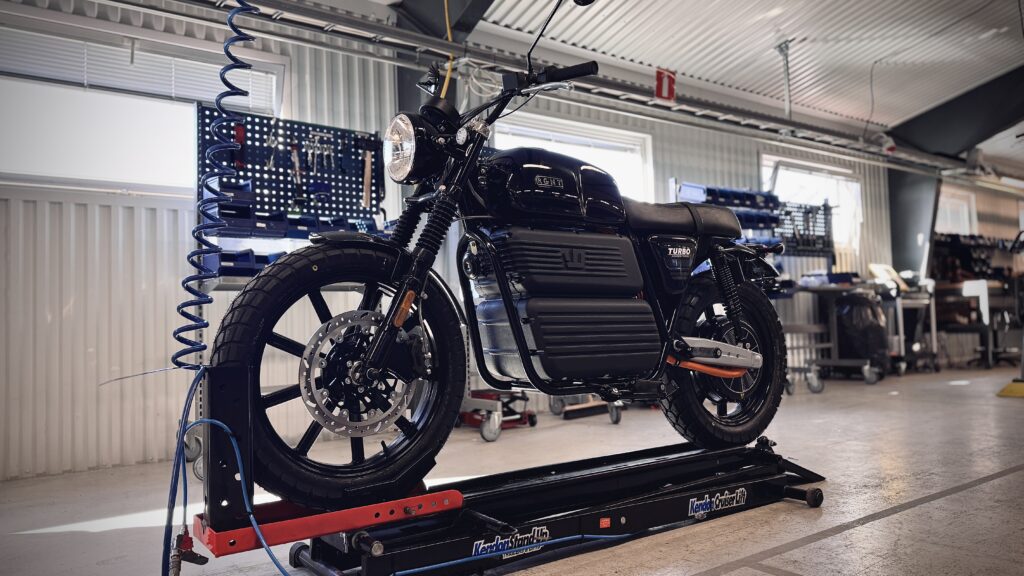
It’s here I meet Gideon for the first time. He moved from the Netherlands to Sweden in 2022 to join RGNT. With 12 years of experience in the motorcycle industry – including at Harley-Davidson and Motul – he has helped build helmet brand Roeg, launched the Distinguished Gentleman’s Ride in Rotterdam (which grew to 1,500 participants), and founded the Rotterdam Dirt Ride, a motorcycle festival in the heart of the city focused on classic motocross bikes.
Given RGNT’s history – and the downfall of other electric motorcycle brands like Cake, Energica, and the ongoing struggles within the KTM group – our conversation naturally turns to their strategy for survival. Today, the company consists of just four people. Gideon explains:
“I honestly don’t know what everyone was doing back when we had 35 employees. Now Jonathan handles finance, product development, and decision-making. I manage marketing and partnerships. Timmy assembles the bikes, and Jonas handles aftersales. Everything is in-house: warehouse, factory, support. It gives us control and keeps costs low.”
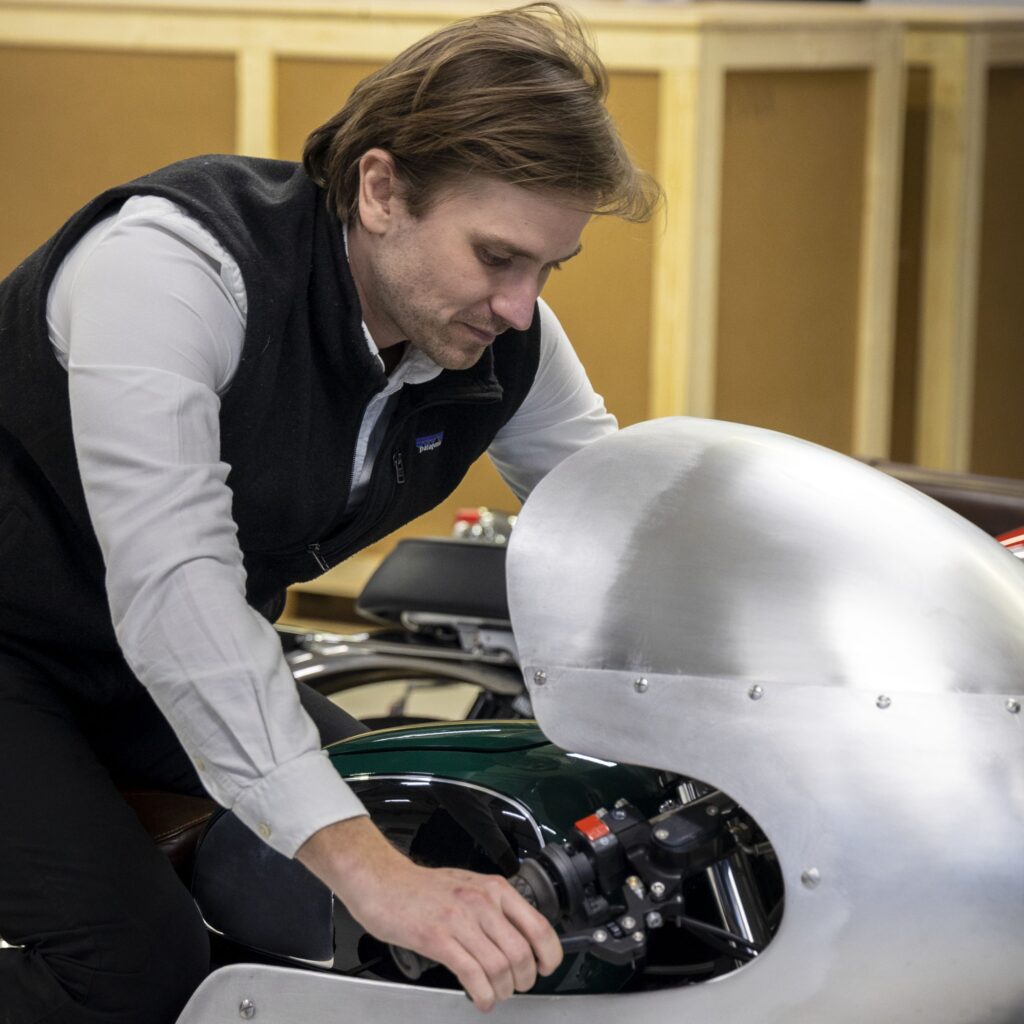

The premises are shared with Jonathan’s other company, Mattr, which manufactures battery systems for clients including the military – and, of course, RGNT’s own bikes. These synergies help keep costs down. Another crucial shift is their focus on ROI (Return on Investment), moving away from the exclusive image that surrounded generations 1 and 2. I recall a story from an earlier visit, about a customer who bought one of the first RGNT bikes just to hang it on the wall of his yacht. In Monaco.
Today, the price has been reduced from around SEK 160,000 to SEK 110,000, with various parts swapped out after careful evaluation. To reach this point, they went back to basics and re-evaluated which features are truly essential. It’s about creating sustainability – both for RGNT and their dealers – without compromising on quality, Gideon explains.
One previous weakness was overheating motors – something that only became apparent when customers from the Alpine region started taking the bikes into the mountains. After all, the bikes were designed for urban use, not mountain goat territory. Now, they’ve switched to a larger motor and a smaller battery – without sacrificing range. And it seems to work. Literally. The team can barely physically manage to stress-test the bikes until the battery runs out – and even then, the motor shows no signs of overheating. Jonathan admits here that a windscreen would be helpful for the rider, even if not visually appealing.
Another former drawback was the need to ship bikes back to Sweden for repairs – expensive and impractical, as Gideon points out. You probably know the feeling yourself: when your pride and joy needs servicing, you want it back as soon as possible. RGNT now focuses on establishing dedicated service points, which currently exist in Germany, France, and Spain.
Apart from that, there’s not much on the bike that requires maintenance; the only regular service needed is replacing brake fluid and wear items like brake pads – keeping ownership costs low. RGNT offers up to five years’ warranty on the battery (often the most expensive part of any electric vehicle), and a quick check with Svedea insurance shows a fully comprehensive cover would cost me SEK 2,584/year, with road tax at just SEK 180/year.
In Sweden, RGNT sells directly to end customers and offers servicing and guided test rides.
“One day, a guy walked past with his dog, got curious, and popped his head in. Half an hour later, he was out test-riding,” Jonathan shares. And today, it was my turn – even the first ride of the year – on the RGNT Turbo, in the stunning white and purple colourway ‘Purple Rain’.
Test Ride: RGNT Turbo
We roll out onto the Halland countryside roads under a clear blue sky. Jonathan and Gideon follow behind in a well-kept, roof-down Saab 900, documenting my ride.
I glide forward in silence – like those moments when I coast to a stop on a petrol bike in neutral – except now, it’s constant and even quieter. All it takes is a push of a button and you’re off. No gears, no foot levers. The front brake is on the right handlebar, and where the clutch lever usually is, there’s a combined brake (also known as CBS) that activates both front and rear.

The design is clean, with a clear 3” display. The Bluetooth icon piques my curiosity, and Gideon tells me a mobile app is set to launch in June 2025 – offering navigation, battery status, and other smart features.
At first, I struggle a bit with the controls, as the buttons are quite small and I keep accidentally activating (or deactivating…) functions I didn’t intend to. To be fair, I’m wearing gloves a size too big – but after a while, I get used to how I need to angle my hands to minimise misclicks.
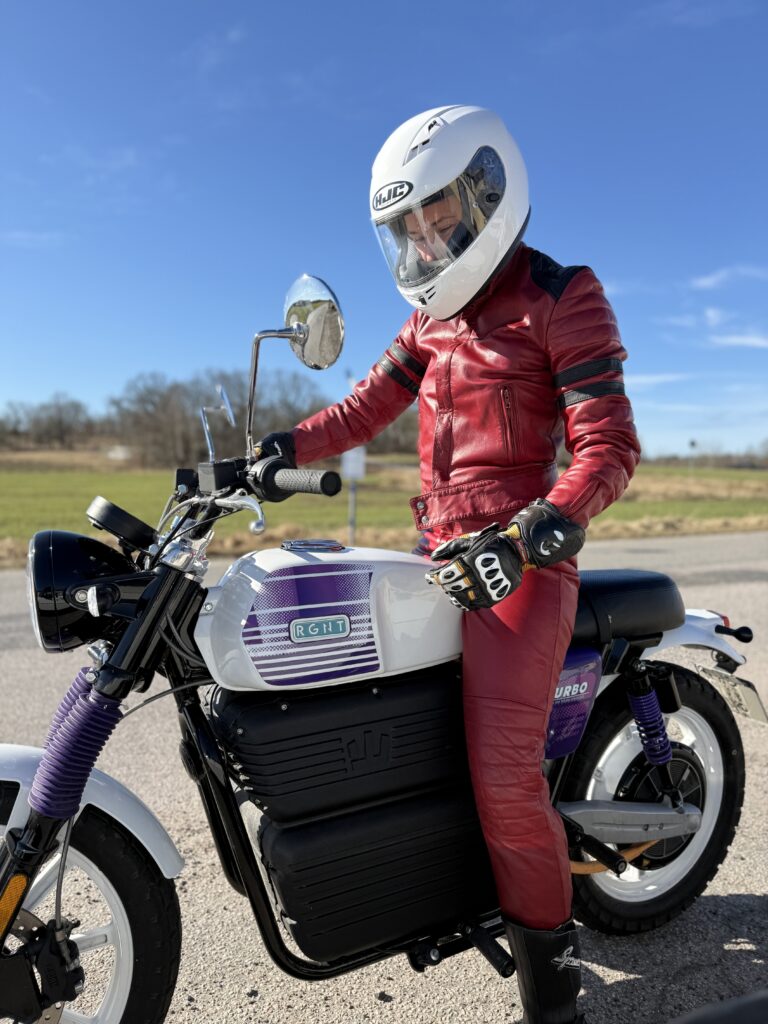
This bike is snappier, better balanced, and quieter than the No.1 I rode in Stockholm on that autumn day six years ago. No surprise really – it now boasts 540 Nm of torque, up from 390. The motor is mounted in the rear hub, eliminating chain noise and reducing wear, which means less motor maintenance.
I start off in ‘Range’ mode – the first of four (Range, Normal, Dynamic, and Turbo) – and the bike feels lively from the get-go. I test each mode in turn, and when I hit ‘Turbo’, my definition of “lively” gets rewritten. The RGNT Turbo reaches its top speed faster than I can process that it’s already there – and that nothing’s wrong with the bike. It’s clear: if there weren’t a speed limiter, it would just keep pulling, and pulling, and pulling some more. It’s reminiscent of that endless power surge you get on a Ducati Streetfighter V4S.
The RGNT Turbo can’t be compared to a standard 125cc or even A2-category bikes like the KTM 390 or BMW 310. Plenty of 600cc bikes would struggle to keep up. And the best part? All this fun is fully legal on a light motorcycle licence – mad!
The suspension leans toward the stiffer side – bumps feel sharp but pass quickly (think sports car). This isn’t meant to be a plush touring bike, and in that sense, it serves its purpose well.
Low-speed balance is excellent. I deliberately mess up a U-turn to test the reverse gear. For shorter riders on taller bikes, repositioning can be a pain – especially on inclines or uneven ground. Now, the RGNT Turbo isn’t particularly tall or heavy to move around, but the reverse gear is still a brilliant bonus. It’s as easy as holding the front brake while pressing the ‘R’ button until an ‘R’ lights up on the display. A slight twist of the throttle gives you just the boost you need in that exact moment.
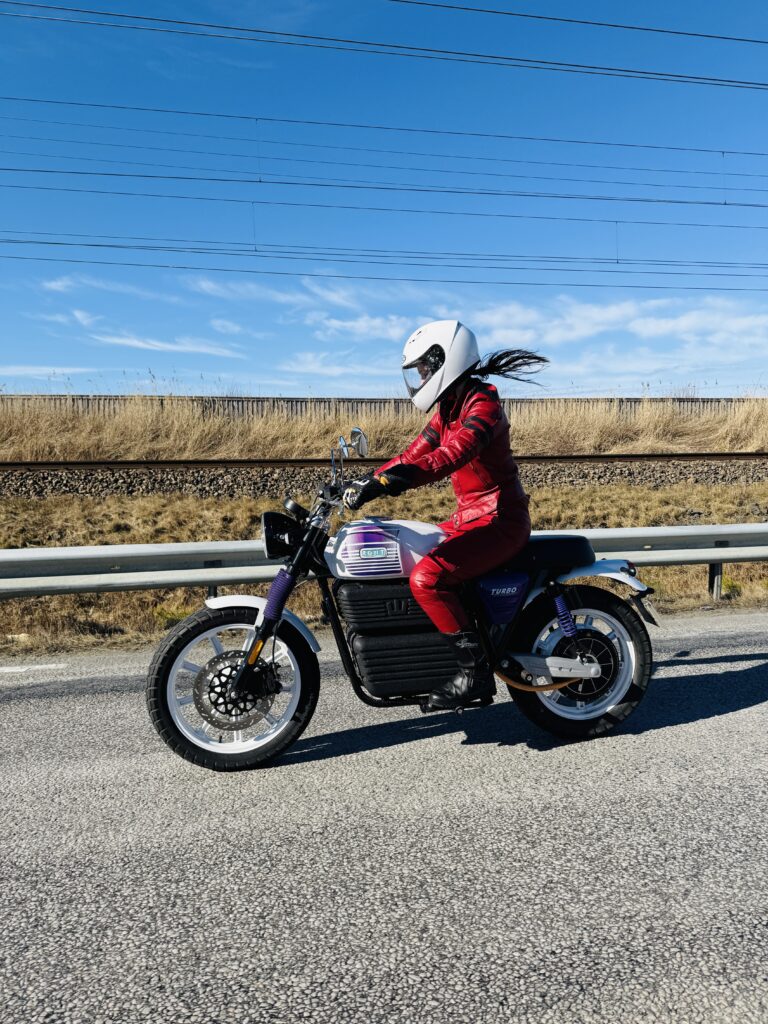
The left-hand lever, which applies both front and rear brakes simultaneously, gives a much smoother braking experience than using just the front. Brake feedback feels a little muted, and the bite isn’t quite as sharp as you’d expect, considering how quickly this bike takes off.
Out on the open road, the RGNT Turbo sits confidently at high speeds, and its low weight makes mid-corner corrections a breeze. A slight shift of the hips and the bike flows with you – it becomes a fluid, floating dance.
Back at the workshop, I move the No.1 to restore order. Instantly, I’m reminded of another difference: the No.1 feels noticeably more top-heavy than the bike I just rode. Jonathan and I both realise – this is probably the very same RGNT No.1 I rode when we first met. The journey hasn’t been linear, but RGNT has undeniably moved forward.
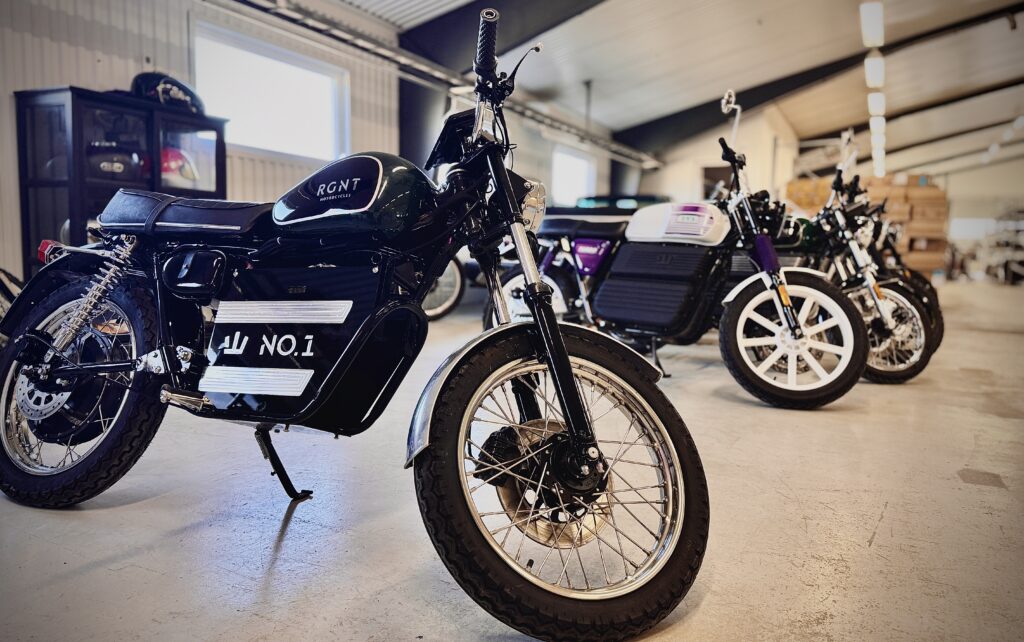
Rationally, I can’t think of a single reason not to get an RGNT Turbo – if I lived in a city or suburb and wanted a bike for commuting or weekend ice cream runs. With some suspension tweaks, improved ergonomics and heated grips, I imagine it would even make a cheeky little scrambler-style gravel bike. RGNT is clearly onto something – they’ve built a strong foundation with potential to evolve into many motorcycle formats.
And they’re already working on it. The RGNT Turbo wasn’t the only bike in the workshop.
As yet unnamed, their next project features a power-to-weight ratio of 0.5 horsepower per kilo. RGNT now has its sights set on conquering Swedish road racing – with a dedicated electric class they hope to dominate.
Stay tuned for the next issue – the excitement is only just beginning.
Quick Facts – RGNT Turbo
- 0–100 km/h: 4 seconds
- Colours: Black Thunder and Purple Rain
- Warranty: 2 years, with optional extended battery warranty (+3 years for a total of 5 years)
- Horsepower: 63 hp (46 kW)
- Licence category: A1 (light motorcycle licence)
- Charging time: 2.1 hours via Type 2 charging port
- Price: SEK 110,000
- Range: 126 km (WLTP)
- Top speed: 120 km/h
- Weight: 160 kg
- Torque: 540 Nm
In summer 2025, a fast-charging package will be available from RGNT dealers, reducing charging time to just 1 hour.

